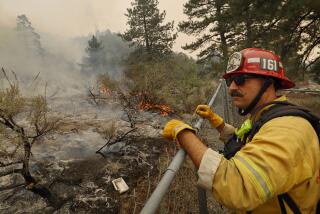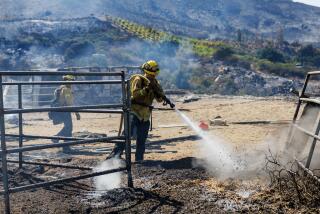Firefighters gain ground on wildfires across California
- Share via
Firefighters are continuing to gain control over a wildfire burning in the San Bernardino National Forest, authorities said Tuesday.
The Lake fire, which ignited last Wednesday south of Highway 38, has burned 17,405 acres and is 30% contained, the U.S. Forest Service said Tuesday morning. The effort to fight the fire has cost $7 million so far, authorities said.
While Highway 38 remained closed, officials said they hoped to open it soon now that they have set up a sturdy defense between the highway and the flames. Nearly 2,000 people are battling the fire.
The Lake fire is the largest wildfire currently burning in California, according to the Forest Service.
In Ventura County, meanwhile, crews continued to battle a fast-moving wildfire that started about 1 p.m. Monday.
The River fire was reported in the Santa Clara River in Santa Paula, said Santa Paula Fire Department spokesman Andy VanSciver. The eastward-moving blaze was fueled by winds and dry brush and had chewed through 140 acres and was 20% contained Monday night, the Ventura County Fire Department tweeted.
Farther north, the Park Hill fire in San Luis Obispo County has burned about 1,800 acres since Saturday, according to the California Department of Forestry and Fire Protection. The fire is 90% contained and has stopped spreading, CalFire said, but not before it destroyed two houses, four mobile homes and nine vehicles, including a pair of recreational vehicles that were used as primary residences.
A wildfire in Madera County that started last week has burned 920 acres and is 90% contained, CalFire said.
With four years of drought and dismal snowpack measurements, firefighters are expecting to see similar wildfire conditions through the summer and fall.
Even when there is rain, it can be a blessing and a curse, experts say.
Northern California’s forests saw an epic drought-fueled fire season in 2014: Fires consumed more than 350,000 acres of national forest by September, compared with 84,109 acres during the same period in 2013. More than 200 structures were destroyed.
Forests on the eastern Sierra Nevada along U.S. 395 are also vulnerable to a fast-moving wildfire, said Kelly Redmond, a climatologist with the Western Regional Climate Center at the Desert Research Institute in Reno. The pieces were set in place last year, when a series of summer tropical storms in the Pacific reached farther north than normal and encouraged the growth of more vegetation.
As the state’s drought persists, however, that extra growth is turning into bone-dry tinder, Redmond said.
“When the precipitation shuts off in the Central Valley, usually sometime in May or June, the valve is pretty much shut off,” Redmond said. “We’ve seen some reports that because of the heavy precipitation in the Great Basin [earlier this year], grasses are practically up to the underbelly of a horse.”
Grass can lead small blazes toward bigger fuel, such as trees that are more difficult to ignite without a persistent source around it. A huge die-out of trees in the Sierra Nevada is also adding to concerns that there’s more to burn, said Tom Rolinski, a Forest Service meteorologist.
CalFire’s Daniel Berlant said his agency has reached a maximum staffing of 7,000 firefighters months earlier than normal.
For breaking California news, follow @JosephSerna.
More to Read
Sign up for Essential California
The most important California stories and recommendations in your inbox every morning.
You may occasionally receive promotional content from the Los Angeles Times.











